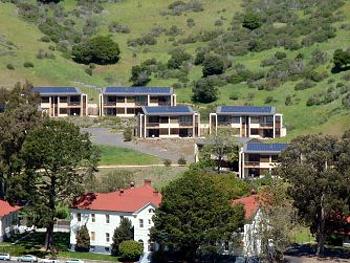 舊金山資產所有權人現在將可透過特殊的自願性財產稅,把申貸資金投注於再生能源、節能與節水計畫上。
舊金山資產所有權人現在將可透過特殊的自願性財產稅,把申貸資金投注於再生能源、節能與節水計畫上。
舊金山市長紐森(Gavin Newsom)於8日簽署通過舊金山的資產評估潔淨能源計畫(Property Assessed Clean Energy,簡稱PACE),是全美目前為止規模最大的PACE計畫。
「這個綠色的融資計畫將會在舊金山創造綠色就業,並刺激下一波的節能、節水與再生能源的發展。」紐森表示:「當住家與資產所有人對建築物進行環境大改造時,這會幫助他們解決所需的大筆先期費用。」
此計劃可提供1億5千萬的債券額度給私有資產所有人。舊金山資產所有人將能自下個月開始申請融資。
PACE計畫根植於傳統性的土地抵押的市政融資。以下為其運作方法。
地方政府規劃一個地區進行改造。發行以此地區內不動產作為擔保的債券,而債券收益用來挹注再生能源與能源效益計畫。資產所有人在其財產稅帳單中,以固定的費用來償還債券上的本息。
每件外加的特殊財產稅將可以20年時間全額付清。
市長辦公室評估,舊金山45%的溫室氣體排放來自於當地建築物的能源使用。乾旱與氣候變遷則威脅著區域用水供應,使得節約用水更顯必要。
即使有稅額優惠與傳統的貸款方式,許多當地家庭與建築物所有人仍無法支付環境改造期間所需要自行支付的先期投資。
研究顯示,妨礙資產所有人進行再生能源、能源效率與節水設施升級的主要障礙就是高額的先期費用。PACE計畫便是設計來移除此項障礙。
資產所有人對此計畫的參與,是百分之百志願的。僅有參與PACE計畫的資產所有人須支付額外的花費。
債券收益乃用來支付參與此計畫的資產中,通過資格預先審查的潔淨能源改造案。資產所有人可選擇能源科技,諸如太陽能板、能源效益計畫,如高效率的暖爐或節水措施。
PACE模式由加州柏克萊的狄維爾斯(Cisco DeVries)所研擬,當時他擔任柏克萊貝茲市長(Tom Bates)的幕僚長。此一概念已擴展至全美,過去18個月之間有17個州通過 PACE計畫。
San Francisco property owners now will be able to finance renewable energy, energy efficiency, and water conservation projects through a voluntary special property tax.
Mayor Gavin Newsom today signed the final legislation required to establish San Francisco's Property Assessed Clean Energy, PACE, program, the nation's largest PACE program to date.
"This green financing program is going to create green jobs and fuel the next wave of energy and water efficiency and renewable energy development in San Francisco," said Mayor Newsom. "It helps home and property owners overcome the large up-front costs of major environmental improvements to their buildings."
The program makes $150 million in bonding capacity available to private property owners. San Francisco property owners will be able to apply for financing beginning next month.
The PACE program is rooted in traditional land-secured municipal finance. Here's how it works.
A local government creates an improvement district. A bond, secured by real property within the district, is issued, and the bond proceeds are used to fund renewable energy and energy efficiency projects. Property owners then repay the debt service on the bond in fixed payments as part of their property tax bill.
Each additional special property tax will be paid in full within 20 years.
The Mayor's Office estimates that 45 percent of San Francisco's greenhouse gas emissions come from energy used in local buildings. Drought and climate change threaten regional water supplies and compel greater water conservation.
Even with tax breaks and traditional loan arrangements, many local home and building owners cannot support the upfront investment for environmental improvements that pay for themselves over time.
Studies have shown that the primary barrier preventing property owners from making renewable energy, energy efficiency, and water conservation upgrades is high upfront costs. PACE programs are designed to remove that barrier.
Property owner participation is 100 percent voluntary. Only those property owners who choose to participate in the PACE program pay additional costs.
The bond proceeds are used to pay for prequalified clean energy improvements on participating properties. Property owners choose renewable energy technology like solar panels, energy efficiency projects like a high efficiency furnace, or water conservation measures.
The PACE model was developed in Berkeley, California by DeVries, who was then serving as chief of staff to Berkeley Mayor Tom Bates. The concept is expanding across the country; 17 states have authorized PACE programs over the past 18 months.
全文及圖片詳見:ENS







